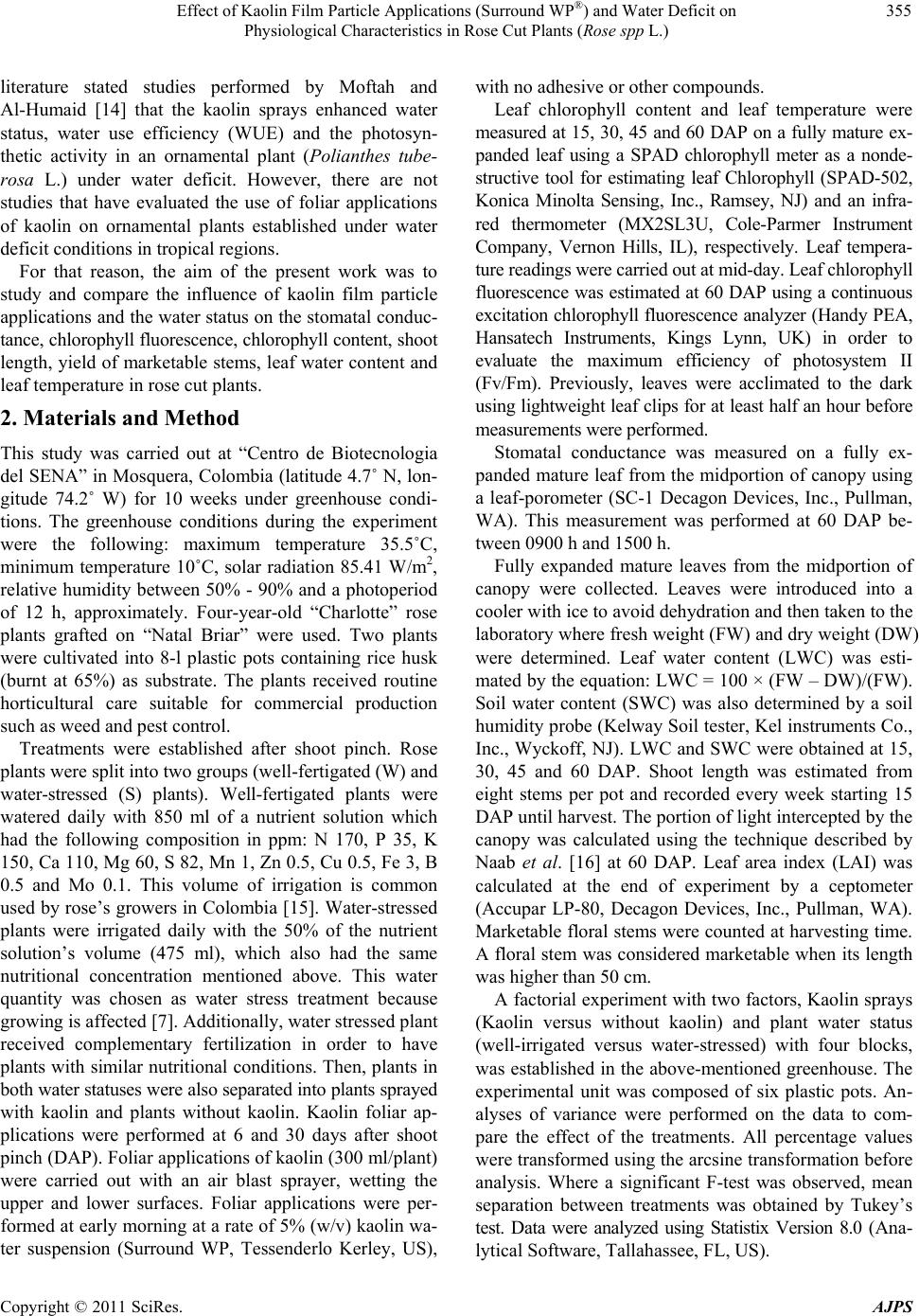
Effect of Kaolin Film Particle Applications (Surround WP®) and Water Deficit on 355
Physiological Characteristics in Rose Cut Plants (Rose spp L.)
literature stated studies performed by Moftah and
Al-Humaid [14] that the kaolin sprays enhanced water
status, water use efficiency (WUE) and the photosyn-
thetic activity in an ornamental plant (Polianthes tube-
rosa L.) under water deficit. However, there are not
studies that have evaluated the use of foliar applications
of kaolin on ornamental plants established under water
deficit conditions in tropical regions.
For that reason, the aim of the present work was to
study and compare the influence of kaolin film particle
applications and the water status on the stomatal conduc-
tance, chlorophyll fluorescence, chlorophyll content, shoot
length, yield of marketable stems, leaf water content and
leaf temperature in rose cut plants.
2. Materials and Method
This study was carried out at “Centro de Biotecnologia
del SENA” in Mosquera, Colombia (latitude 4.7˚ N, lon-
gitude 74.2˚ W) for 10 weeks under greenhouse condi-
tions. The greenhouse conditions during the experiment
were the following: maximum temperature 35.5˚C,
minimum temperature 10˚C, solar radiation 85.41 W/m2,
relative humidity between 50% - 90% and a photoperiod
of 12 h, approximately. Four-year-old “Charlotte” rose
plants grafted on “Natal Briar” were used. Two plants
were cultivated into 8-l plastic pots containing rice husk
(burnt at 65%) as substrate. The plants received routine
horticultural care suitable for commercial production
such as weed and pest control.
Treatments were established after shoot pinch. Rose
plants were split into two groups (well-fertigated (W) and
water-stressed (S) plants). Well-fertigated plants were
watered daily with 850 ml of a nutrient solution which
had the following composition in ppm: N 170, P 35, K
150, Ca 110, Mg 60, S 82, Mn 1, Zn 0.5, Cu 0.5, Fe 3, B
0.5 and Mo 0.1. This volume of irrigation is common
used by rose’s growers in Colombia [15]. Water-stressed
plants were irrigated daily with the 50% of the nutrient
solution’s volume (475 ml), which also had the same
nutritional concentration mentioned above. This water
quantity was chosen as water stress treatment because
growing is affected [7]. Additionally, water stressed plant
received complementary fertilization in order to have
plants with similar nutritional conditions. Then, plants in
both water statuses were also separated into plants sprayed
with kaolin and plants without kaolin. Kaolin foliar ap-
plications were performed at 6 and 30 days after shoot
pinch (DAP). Foliar applications of kaolin (300 ml/plant)
were carried out with an air blast sprayer, wetting the
upper and lower surfaces. Foliar applications were per-
formed at early morning at a rate of 5% (w/v) kaolin wa-
ter suspension (Surround WP, Tessenderlo Kerley, US),
with no adhesive or other compounds.
Leaf chlorophyll content and leaf temperature were
measured at 15, 30, 45 and 60 DAP on a fully mature ex-
panded leaf using a SPAD chlorophyll meter as a nonde-
structive tool for estimating leaf Chlorophyll (SPAD-502,
Konica Minolta Sensing, Inc., Ramsey, NJ) and an infra-
red thermometer (MX2SL3U, Cole-Parmer Instrument
Company, Vernon Hills, IL), respectively. Leaf tempera-
ture readings were carried out at mid-day. Leaf chlorophyll
fluorescence was estimated at 60 DAP using a continuous
excitation chlorophyll fluorescence analyzer (Handy PEA,
Hansatech Instruments, Kings Lynn, UK) in order to
evaluate the maximum efficiency of photosystem II
(Fv/Fm). Previously, leaves were acclimated to the dark
using lightweight leaf clips for at least half an hour before
measurements were performed.
Stomatal conductance was measured on a fully ex-
panded mature leaf from the midportion of canopy using
a leaf-porometer (SC-1 Decagon Devices, Inc., Pullman,
WA). This measurement was performed at 60 DAP be-
tween 0900 h and 1500 h.
Fully expanded mature leaves from the midportion of
canopy were collected. Leaves were introduced into a
cooler with ice to avoid dehydration and then taken to the
laboratory where fresh weight (FW) and dry weight (DW)
were determined. Leaf water content (LWC) was esti-
mated by the equation: LWC = 100 × (FW – DW)/(FW).
Soil water content (SWC) was also determined by a soil
humidity probe (Kelway Soil tester, Kel instruments Co.,
Inc., Wyckoff, NJ). LWC and SWC were obtained at 15,
30, 45 and 60 DAP. Shoot length was estimated from
eight stems per pot and recorded every week starting 15
DAP until harvest. The portion of light intercepted by the
canopy was calculated using the technique described by
Naab et al. [16] at 60 DAP. Leaf area index (LAI) was
calculated at the end of experiment by a ceptometer
(Accupar LP-80, Decagon Devices, Inc., Pullman, WA).
Marketable floral stems were counted at harvesting time.
A floral stem was considered marketable when its length
was higher than 50 cm.
A factorial experiment with two factors, Kaolin sprays
(Kaolin versus without kaolin) and plant water status
(well-irrigated versus water-stressed) with four blocks,
was established in the above-mentioned greenhouse. The
experimental unit was composed of six plastic pots. An-
alyses of variance were performed on the data to com-
pare the effect of the treatments. All percentage values
were transformed using the arcsine transformation before
analysis. Where a significant F-test was observed, mean
separation between treatments was obtained by Tukey’s
test. Data were analyzed using Statistix Version 8.0 (Ana-
lytical Software, Tallahassee, FL, US).
Copyright © 2011 SciRes. AJPS